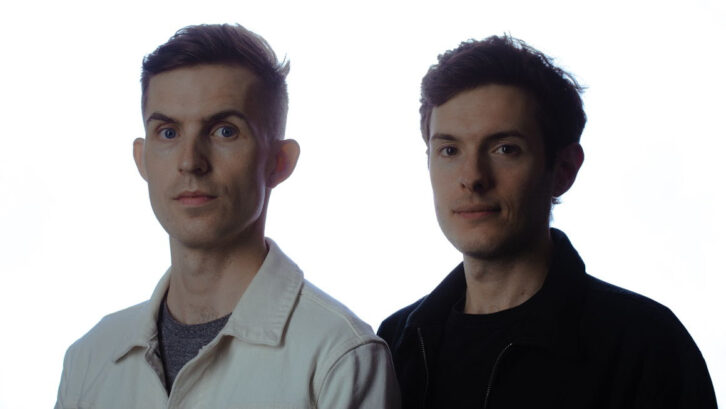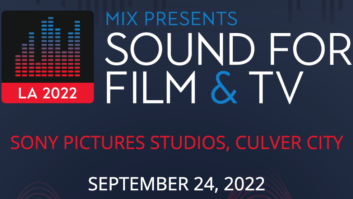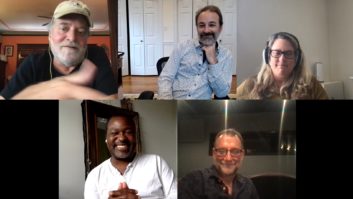
Bristol, United Kingdom and Calgary, Canada, April 25, 2023 – As teenagers in the United Kigndom, Koan Sound’s Will Weeks and Jim Bastow played in bands while absorbing the diverse influences of an artistically-flourishing Bristol. “The drum and bass scene was really big, the dubstep scene was just starting to gain momentum, and you also had acts like Massive Attack and Portishead,” Bastow recalls. As two friends came of age, they found their interests shifting from playing instruments into production, excited by the burgeoning possibilities of electronic music. “Our biggest influences on the production front were artists like Noisia and Spore,” Weeks says. “Hearing that heavy neurofunk sound is definitely what got us obsessed with sound design. We wanted to make those kinds of sounds ourselves.” Armed with Weeks’s brother’s copy of an early version of Reason, they began experimenting, discovering what kinds of sounds might result from their unique blend of influences. As they advanced to other DAWs, ultimately landing on Ableton Live, their resulting musical output would garner the duo a reputation for crisp, organic, and at times hard-hitting production, inflected with a distinct sense of melody and harmony.
While much of Weeks and Bastow’s production takes place on the computer, live instruments and sounds have never entirely left their vocabulary. “We pretty much try to blend what we learned from neurofunk sound design with the kind of live music that we listen to,” Weeks says. “We use a lot of organic sounds from foley. And as our tastes have continued to evolve, we’ve incorporated stuff we hear from other genres, like jazz or metal.” Bastow notes that bringing these disparate influences together helps them create dynamic productions that make their music distinct from that of other artists working in their space. “Contrast is a really important thing for us,” he says. “I think that music is more compelling when there are interesting aesthetic juxtapositions. With our music we strive to make it hard-hitting but also have subtlety and depth to it.” Contrast also shapes the duo’s collaborative workflow, with complementary skills helping them build their intricate compositions. “I come from a piano background, so I tend to gravitate towards melodies and harmonies more,” Bastow says. “Will comes from a drumming background, so he’s focused more on rhythm and sound design. But within that framework there’s still a lot of overlap and blending into each other’s areas.”
Tools of the trade
Having spent much of their early development as producers working with few if any third-party plug-ins, Bastow and Weeks have adopted an ethos of economy rather than indulgence when it comes to software. “I personally prefer to focus on learning the tools I have inside and out rather than trying to get my hands on every tool that’s out there,” Bastow says. But Weeks notes that there is always a path for something compelling to enter their workflow. “At this point in our career, we’ve learned a lot about the theory behind how certain effects work, so now we can look at a new plug-in and figure out more precisely what we can get out of it and whether it might add something to what we do.”
One plug-in maker whose design sensibilities have appealed to Bastow and Weeks enough to warrant exploration is Polyverse Music, whose Gatekeeper, Manipulator, and Comet plug-ins have found their way into Weeks and Bastow’s workflows over the last several years. The company’s latest release—a filter called Supermodal—has since joined that arsenal. At the heart of Supermodal lies a unique modal filter, which combines hundreds of narrow bandpass filters to replicate the behaviors of resonating bodies, real and imagined. A state variable filter—morphing from high-pass to band-pass to low-pass behaviors—runs parallel to the modal filter to allow the blending in of more conventional filtering effects. Though the underlying behavior of Supermodal’s modal filter is complex, Bastow found the plug-in’s GUI immediately inviting. “Right away I appreciated from a UI perspective how the important things are very clear and center,” he says. ”The state variable filter is the first thing you see. Then the drive. So you’re starting somewhere very familiar. Then you move on to the modal filter, and that’s where you can really start experimenting with interesting and unusual tones of different kinds. So there’s a very clear path for designing your sound that’s quite pleasing.”
One-stop shop
Supermodal’s robust modulation section—with its four modulation slots and six modulation source options—presents extensive options for Bastow and Weeks to manipulate the behavior of the filters. “Having these extended modulation capabilities within the plug-in itself is great,” Bastow says. “You don’t have to resort to other external LFOs or Max for Live devices just to modulate plug-in parameters. It makes the user experience a lot more streamlined and intuitive.” Weeks concurs, particularly enjoying the possibilities of the randomness modulator. “The modulation controls are really powerful,” Weeks says. “The ability to apply randomness to any parameter in a really controlled way lets you do things like move the frequency of the filter up and down in octaves rhythmically and get these syncopated harmonic tones coming in and out. And again, you can tune that to the midi that you have already. It’s very good for working with melody, and we always have a lot of melody in our tracks.”

For Weeks, one of Supermodal’s key assets is its extensive midi implementation. “I seriously love Supermodal,” he says. “I really like how easy it is to inject melody and harmonics into pretty crazy sound design by using midi to tune the frequency of the filter. We frequently automate filters to generate different harmonics and sounds before going into distortion, especially when processing bass. It can take a lot of time to do that kind of automation, especially when the bass is moving around a lot, but with Supermodal you can do that very easily with midi. And then you can add all kinds of other tones and textures to those harmonics with the modal filter. It’s really fun to play around with.”
Spreading the knowledge
Since 2020, Bastow and Weeks have begun sharing their expertise via their Patreon page in addition to working on forthcoming music releases, providing an opportunity for fans of their output to engage with them and learn. “Our Patreon was something that we started fairly early in the pandemic,” Bastow says. “We were at a point where we had built up a lot of knowledge, tools, and techniques and wanted to share those and give something back. And it really turned into a new outlet for our creativity and a way to connect with a subset of our fanbase that’s interested in the technical aspect of what we do. We aim to put out very high quality and well-researched video tutorials with an emphasis on our intake and our production techniques.”
Their tutorials occasionally feature plug-in demos, which have included Polyverse’s Gatekeeper, which delivers rhythmic volume automation envelopes. “We’ve shown Gatekeeper a couple times,” Weeks says. “I like using it to create these rhythmic, gated, choppy harmonic pads. So I’ll put a sound with a lot of reverb and really long delays through it and use Gatekeeper to turn it into a more rhythmic element.” Like Supermodal, Gatekeeper allows extensive parameter control, allowing Bastow to tweak its envelopes to his liking. “One of the great things about Gatekeeper is how snappy you can make the envelopes by turning the Smooth control all the way down and making the timing really precise,” he says. “It’s so great to be able to adjust that one knob and have it globally adjust all the envelopes as opposed to having to manually adjust each one by hand. It’s just like with the other Polyverse plug-ins, everything you need is housed within the plug-in itself.”

Remote possibilities
While he and Weeks are now split between Bristol and Calgary, Alberta, they stay connected through remote collaboration. “We’re usually working on projects independently and sending them back and forth,” Weeks explains. “I can save a project, upload the file, and then Jim will wake up and continue working on it.” It’s a workflow that—given the time difference—Bastow jokes provides “maximum efficiency.” While they are beloved by fans for their ability to create sounds that are ear-catching, expansive, and at times complex, they always advise simplicity as a baseline for their proteges. “It’s important to start with the basics and build from there,” Weeks says. “Learn when a certain effect works or doesn’t work, and try to really think about why that’s the case,” recalls Bastow. “Once you understand those fundamentals, you’ll recognize more quickly which tools you can really connect to.” This approach helps them recognize the potential of a tool when it comes their way. “You can see right away that a lot of thought has gone into the design of a plug-in, and you can also recognize the potential for what you can do with it,” Bastow says. “You know at a glance that it’s something that’s worth diving into.”
For more information about Koan Sound, please visit: https://www.koansound.com/
For more information about Polyverse, please visit https://polyversemusic.com
ABOUT POLYVERSE
Polyverse Music is a “by musicians, for musicians” company that creates uniquely powerful tools and instruments for artists on the cutting edge of creativity. Founded in 2015, Polyverse has continually set the bar in terms of plugin innovation, vision, and user experience. Every person on the Polyverse team is a forward-thinking musician with extensive knowledge and experience with music, sound, synthesizers, and technology. In each new step, Polyverse continues to push the boundary of possibilities with digital musical instruments and effects.







